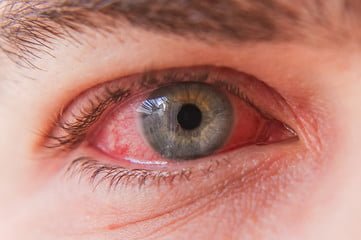Pink Eye Infection In Pakistan: Preventing Pink Eye in Pakistani Cities
Pink eye (conjunctivitis) is causing a lot of trouble in Punjab, especially in Lahore. Hospitals in the province are seeing 500-600 patients, and Lahore is the hardest-hit city.
It’s not just one age group affected; people of all ages are getting sick. Many kids who go to school are getting eye infections because they aren’t being careful enough.
Some schools are letting students stay home as soon as they get sick and telling parents to take care of them.
Doctors say that pink eye is spreading quickly in crowded cities where people are around not-so-clean places like factories, markets, and malls.
Lahore is the worst-hit city, with almost 40 percent of all cases. Over 200 people are going to hospitals in Lahore every day because of pink eye.
Eye experts are worried that the infection could spread even more because people aren’t taking enough precautions, especially against viral conjunctivitis.
A top eye doctor, Prof Dr. Asad Aslam, said it’s too early to know exactly how many cases there are. Pink eye affects the lining of your eyelids and eyeballs, but it can be treated at any stage.
He also said that it can spread easily if you touch contaminated stuff or talk to someone who’s infected. So if you have pink eye, you should be super careful.
He suggested wearing sunglasses, using separate bedding and dishes, and being really careful with your hands. He also said the virus can spread when you touch your eye and then touch other things or people.
What Is Pink Eye (Conjunctivitis)?
Pink eye is when the clear covering inside your eyelids and over your eyeball gets red and swollen. This covering is called the conjunctiva. The small blood vessels in the conjunctiva can swell and get irritated, making your eyes look pink or reddish. People also call pink eye “conjunctivitis.”
Most of the time, pink eye happens because of a viral infection. But it can also be caused by a bacterial infection, allergies, or, in babies, when their tear ducts don’t open all the way.
Pink eye can be annoying, but it usually doesn’t mess with your vision. There are treatments that can make it feel better. Since pink eye can spread from person to person, it’s a good idea to see a doctor early and take some precautions to keep it from spreading.
Symptoms
The signs of pink eye you might notice include:
- Your eyes turning red, either in one or both.
- Feeling itchy in one or both eyes.
- Like there’s sand in your eyes.
- Goopy stuff in one or both eyes that dries and makes it hard to open them in the morning.
- Tears coming out.
- Feeling like bright light hurts your eyes, known as “photophobia.”
Causes of Pink Eye
Pink eye can happen for various reasons, including:
- Viruses: These tiny organisms can cause pink eye. The adenovirus is a common culprit, but there are other viruses like herpes simplex and varicella-zoster that can lead to pink eye as well.
- Bacteria: Certain bacteria can also trigger pink eye. Sometimes, it comes along with colds or respiratory infections. If you wear contact lenses that aren’t clean or don’t belong to you, it can lead to bacterial pink eye.
- Allergies: Pink eye can be an allergic reaction, typically affecting both eyes. Allergens like pollen can set it off. When your body senses these allergens, it releases substances that cause inflammation, like histamines. This can make your eyes turn red or pink.
- Chemical or Object Irritation: Sometimes, pink eye happens when your eye gets irritated by chemicals (like if something splashes in your eye) or if a foreign object gets in there. Flushing and cleaning your eye can help, and usually, it clears up on its own in a day.
- Blocked Tear Duct in Newborns: Babies can get pink eye if their tear ducts aren’t fully open yet.
Viral and Bacterial Conjunctivitis
- Most pink eye cases are because of the adenovirus, but other viruses like herpes and varicella-zoster can cause it too.
- Both viral and bacterial types can happen when you have a cold or respiratory infection. Using contact lenses that aren’t clean or aren’t yours can lead to bacterial pink eye.
- These types are very contagious. You can catch them through direct or indirect contact with the liquid that comes from an infected person’s eye. It can affect one or both eyes.
Allergic Conjunctivitis
- This affects both eyes and is a response to allergies, like pollen.
- When you’re allergic to something, your body makes a special antibody called immunoglobulin E (IgE). This triggers cells in your eyes and airways to release substances like histamines, which can make your eyes red or pink.
- Allergic conjunctivitis can make your eyes itchy, watery, and swollen, and you might also have sneezing and a runny nose. Allergic pink eye can be managed with allergy eye drops, and it’s not contagious.
Conjunctivitis from Irritation
- If your eye gets irritated by a chemical splash or a foreign object, it can lead to conjunctivitis. Flushing and cleaning your eye can help, and usually, the symptoms go away on their own within a day.
- If the symptoms persist or the chemical was harsh (like lye), it’s crucial to see a healthcare provider or eye specialist promptly because a chemical splash can damage your eye. Ongoing symptoms could mean the foreign object is still in your eye, or you might have a scratch on the cornea or the membrane covering the eyeball, called the conjunctiva.
Risk Factors
Things that can increase your chances of getting pink eye are:
- Being around someone who has the viral or bacterial kind.
- Being around something you’re allergic to, which can lead to allergic pink eye.
- Wearing contact lenses, especially if you wear them for a long time.
Complications
Pink eye can sometimes make your cornea (the clear part at the front of your eye) swell up and affect your vision, in both kids and grown-ups. If you have:
- Eye pain.
- Feeling like there’s something in your eye.
- Vision that’s not clear.
- Eyes that are sensitive to light.
It’s important to see your healthcare provider quickly. They can help lower the risk of problems.
Preventing Pink Eye
To stop pink eye from spreading, you can do things like:
- Avoid touching your eyes with your hands.
- Wash your hands a lot.
- Use a clean towel and washcloth every day.
- Don’t share towels or washcloths.
- Change your pillowcases regularly.
- Get rid of old eye makeup, like mascara.
- Don’t share eye makeup or your personal eye stuff.
Remember, pink eye isn’t more contagious than a regular cold. So, if you can keep good hygiene and avoid getting really close to others, it’s usually fine to go back to work, school, or child care when you or your child start feeling better. But if you have to be really close to others at work, school, or child care, it might be better to stay home until the symptoms go away.
Preventing Pink Eye in Newborns
Newborn babies can get bacteria in their eyes when they’re born, especially if the bacteria are in their mom’s birth canal. Sometimes, this can lead to a serious kind of pink eye called “ophthalmia neonatorum,” which can hurt their eyesight. That’s why right after they’re born, doctors put antibiotic ointment in their eyes to stop this infection from happening. It helps protect their eyes.
When to See a Doctor
Sometimes, eye problems can make your eyes red. These problems might make your eyes hurt, feel like something’s stuck in them, make your vision blurry, or make light bothersome. If you feel any of these, you should see a doctor quickly.
If you wear contact lenses, stop wearing them when pink eye shows up. If your symptoms don’t start getting better in about 12 to 24 hours, set up a visit with your eye doctor to make sure you don’t have a more serious eye infection because of your contact lenses.


